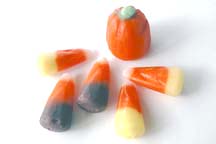
Eleanor Nakama-Mitsunaga
![]()

|
This variety of corn is available year-round, but October is peak season. Unlike other maize varieties sold by the cob, this particular variety is sold in distinctive tri-colored kernels.The basics: Candy corn originated in the United States, conceived by the Wunderle Candy Co. of Philadelphia in the 1880s. The Goelitz Confectionery Co. (now the Jelly Belly Co.) started making candy corn around the 1900s and was so successful that the product is said to have carried the company through two world wars and the Depression.
Back then, candy corn was considered revolutionary because of its multicolored layers. Making it was labor-intensive, requiring hot candy mix to be poured into tiny cornstarch molds in three passes to achieve the white, orange and yellow layers.
The reason for the corn kernel shape isn't known, but candies in other vegetable shapes were also being made at the time.
The candy is essentially a combination of sugar and corn syrup with different manufacturers adding gelatin, marshmallow ingredients and honey to make their versions distinctive. The kernel is slightly chewy with an ultrasweet flavor similar to frosting. The taste is described as sweet vanilla (with some companies now making a seasonal chocolate-flavored corn).
Candy corn has become synonymous with Halloween because of its coloring. Approximately 20 million pounds are sold during the Halloween season.
Selecting: Candy corn comes in a variety of packaging. Make sure all layers are intact. In some bags you'll find the white tips broken off, and what fun is that?
Storing: Transfer candy corn into a clear candy jar, and leave it on the counter in everyone's reach. It should last for several months, but it'll probably be gone by Halloween.
Use: Candy corn is best eaten out of hand, but it can be used to decorate Halloween treats such as cupcakes or a jack-o-lantern cake. You can also create candy mixes using candy corn, gummy candies, M&Ms and other sweets for a dentist's nightmare.
Where to buy: Candy corn is abundant wherever Halloween candy is sold. Prices range from $1 to $2 depending on quantity and packaging.
Eleanor Nakama-Mitsunaga is
a free-lance food writer. Contact her
online through features@starbulletin.com

